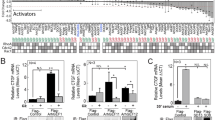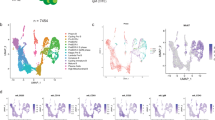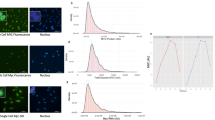Abstract
Proliferation of higher eukaryotic cells is triggered by the proto-oncogene c-myc (myc), which is induced downstream of a large number of growth factor receptors. Myc, a basic helix–loop–helix leucine zipper transcription factor, transmits growth signals by up- and downregulation of target genes. The importance of Myc in growth control is well established. However, the number of growth control genes requiring Myc as an essential factor for regulation after mitogenic stimulation of cells is not yet clear. Here, we have studied the transcriptional programme of a human B-cell line, P493-6, in response to Myc and serum. P493-6 cells do not express the endogenous myc, nor is it induced by serum stimulation. Proliferation of the cells is dependent upon both the expression of a tetracycline-regulated myc gene and serum stimulation. Using DNA microarrays, expression profiling was performed following stimulation of cells with serum, with Myc, or with both. We observed serum regulation of >1000 genes. A number of these genes were synergistically or antagonistically regulated by Myc. Moreover, we identified >300 Myc-regulated genes that were almost unresponsive to serum. Gene ontology analysis revealed that a high proportion of Myc target genes are involved in ribosome biogenesis and tRNA metabolism. The data support our current notion that Myc is essential for the regulation of a large number of growth-related genes in B cells, and cannot be replaced by other serum-induced factors.
This is a preview of subscription content, access via your institution
Access options
Subscribe to this journal
Receive 50 print issues and online access
$259.00 per year
only $5.18 per issue
Buy this article
- Purchase on Springer Link
- Instant access to full article PDF
Prices may be subject to local taxes which are calculated during checkout


Similar content being viewed by others
References
Armelin HA, Armelin MC, Kelly K, Stewart T, Leder P, Cochran BH and Stiles CD . (1984). Nature, 310, 655–660.
Bush A, Mateyak M, Dugan K, Obaya A, Adachi S, Sedivy J and Cole M . (1998). Genes Dev., 12, 3797–3802.
Cho RJ, Huang M, Campbell MJ, Dong H, Steinmetz L, Sapinoso L, Hampton G, Elledge SJ, Davis RW and Lockhart DJ . (2001). Nat. Genet., 27, 48–54.
Dadgostar H, Zarnegar B, Hoffmann A, Qin XF, Truong U, Rao G, Baltimore D and Cheng G . (2002). Proc. Natl. Acad. Sci. USA, 99, 1497–1502.
Eilers M, Schirm S and Bishop JM . (1991). EMBO J., 10, 133–141.
Eisen MB, Spellman PT, Brown PO and Botstein D . (1998). Proc. Natl. Acad. Sci. USA, 95, 14863–14868.
Fernandez PC, Frank SR, Wang L, Schroeder M, Liu S, Greene J, Cocito A and Amati B . (2003). Genes Dev., 17, 1115–1129.
Frank SR, Parisi T, Taubert S, Fernandez P, Fuchs M, Chan HM, Livingston DM and Amati B . (2003). EMBO Rep., 4, 575–580.
Frank SR, Schroeder M, Fernandez P, Taubert S and Amati B . (2001). Genes Dev., 15, 2069–2082.
Grandori C, Wu KJ, Fernandez P, Ngouenet C, Grim J, Clurman BE, Moser MJ, Oshima J, Russell DW, Swisshelm K, Frank S, Amati B, Dalla-Favera R and Monnat Jr RJ . (2003). Genes Dev., 17, 1569–1574.
Iyer VR, Eisen MB, Ross DT, Schuler G, Moore T, Lee JC, Trent JM, Staudt LM, Hudson Jr J, Boguski MS, Lashkari D, Shalon D, Botstein D and Brown PO . (1999). Science, 283, 83–87.
Kaczmarek L, Hyland JK, Watt R, Rosenberg M and Baserga R . (1985). Science, 228, 1313–1315.
Li C and Wong WH . (2001). Proc. Natl. Acad. Sci. USA, 98, 31–36.
Newton JS, Li J, Ning ZQ, Norton JD and Murphy JJ . (1996). Biochem. Soc. Trans., 24, 7S.
Norvell A, Mandik L and Monroe JG . (1995). J. Immunol., 154, 4404–4413.
Oster SK, Ho CS, Soucie EL and Penn LZ . (2002). Adv. Cancer Res., 84, 81–154.
Pajic A, Spitkovsky D, Christoph B, Kempkes B, Schuhmacher M, Staege MS, Brielmeier M, Ellwart J, Kohlhuber F, Bornkamm GW, Polack A and Eick D . (2000). Int. J. Cancer, 87, 787–793.
Schlosser I, Holzel M, Murnseer M, Burtscher H, Weidle UH and Eick D . (2003). Nucleic Acids Res., 31, 6148–6156.
Schuhmacher M, Kohlhuber F, Holzel M, Kaiser C, Burtscher H, Jarsch M, Bornkamm GW, Laux G, Polack A, Weidle UH and Eick D . (2001). Nucleic Acids Res., 29, 397–406.
Schuhmacher M, Staege MS, Pajic A, Polack A, Weidle UH, Bornkamm GW, Eick D and Kohlhuber F . (1999). Curr. Biol., 9, 1255–1258.
Tavazoie S, Hughes JD, Campbell MJ, Cho RJ and Church GM . (1999). Nat. Genet., 22, 281–285.
Tusher VG, Tibshirani R and Chu G . (2001). Proc. Natl. Acad. Sci. USA, 98, 5116–5121.
Watson JD, Oster SK, Shago M, Khosravi F and Penn LZ . (2002). J. Biol. Chem., 277, 36921–36930.
Winkles JA . (1998). Prog. Nucleic Acid Res. Mol. Biol., 58, 41–78.
Zeller KI, Jegga AG, Aronow BJ, O'Donnell KA and Dang CV . (2003). Genome Biol., 4, R69.
Acknowledgements
This work was supported by the DFG (EI 216/8-1) and Fonds der Chemischen Industrie.
Author information
Authors and Affiliations
Corresponding author
Additional information
Supplementary Information accompanies the paper on Oncogene website (http://www.nature.com/onc).
Supplementary information
Rights and permissions
About this article
Cite this article
Schlosser, I., Hölzel, M., Hoffmann, R. et al. Dissection of transcriptional programmes in response to serum and c-Myc in a human B-cell line. Oncogene 24, 520–524 (2005). https://doi.org/10.1038/sj.onc.1208198
Received:
Revised:
Accepted:
Published:
Issue Date:
DOI: https://doi.org/10.1038/sj.onc.1208198
Keywords
This article is cited by
-
Expression and clinical significance of PD-L1 and c-Myc in non-small cell lung cancer
Journal of Cancer Research and Clinical Oncology (2019)
-
Enhancer invasion shapes MYCN-dependent transcriptional amplification in neuroblastoma
Nature Genetics (2018)
-
Disruption of the RP-MDM2-p53 pathway accelerates APC loss-induced colorectal tumorigenesis
Oncogene (2017)
-
Transcriptome analysis of dominant-negative Brd4 mutants identifies Brd4-specific target genes of small molecule inhibitor JQ1
Scientific Reports (2017)
-
TGF-β1 Induces Polypyrimidine Tract-Binding Protein to Alter Fibroblasts Proliferation and Fibronectin Deposition in Keloid
Scientific Reports (2016)



